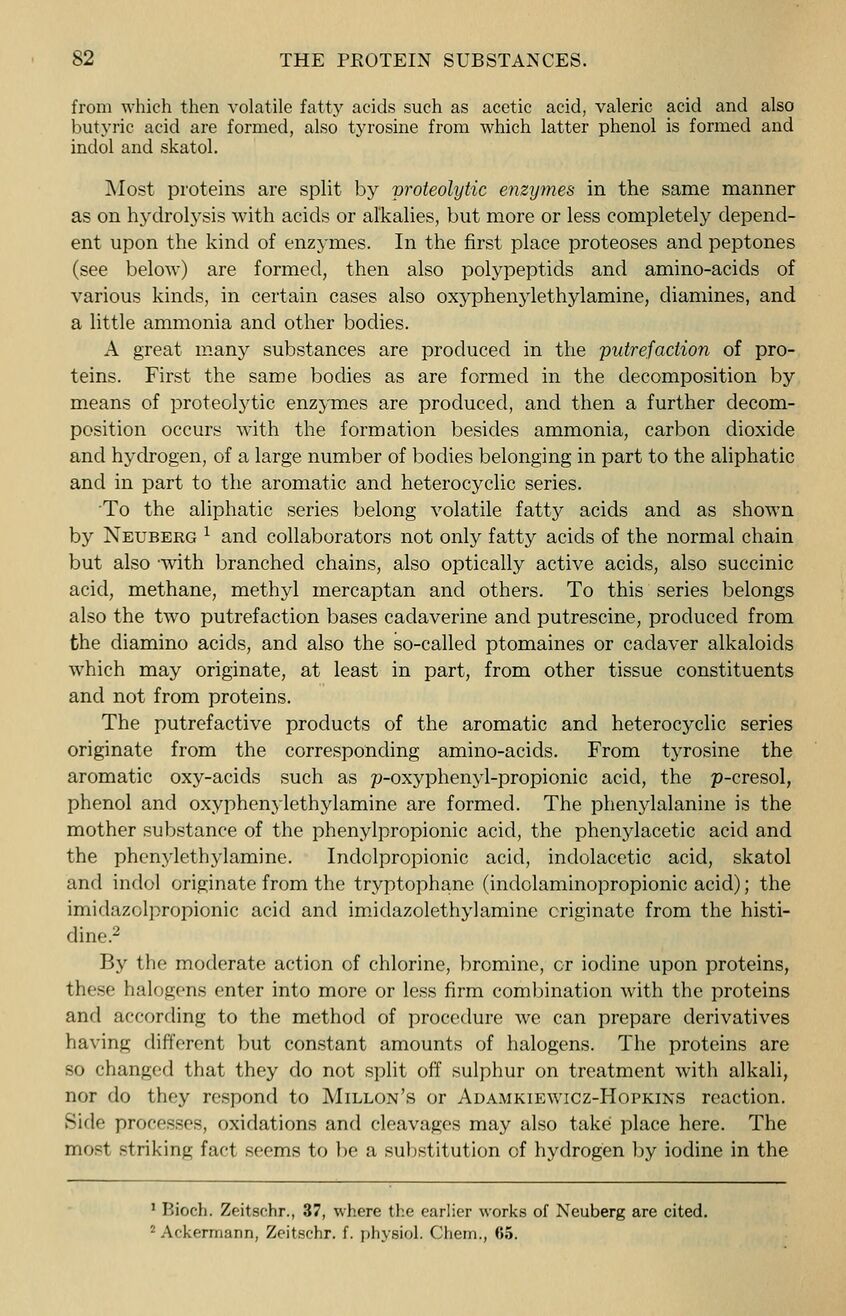
Full resolution (JPEG) - On this page / på denna sida - II. The Protein Substances

<< prev. page << föreg. sida << >> nästa sida >> next page >>
Below is the raw OCR text
from the above scanned image.
Do you see an error? Proofread the page now!
Här nedan syns maskintolkade texten från faksimilbilden ovan.
Ser du något fel? Korrekturläs sidan nu!
This page has never been proofread. / Denna sida har aldrig korrekturlästs.
82 THE PKOTEIN SUBSTANCES.
from which then volatile fatty acids such as acetic acid, valeric acid and also
butyric acid are formed, also tyrosine from which latter phenol is formed and
indol and skatol.
Most proteins are split by proteolytic enzymes in the same manner
as on hydrolysis with acids or alkalies, but more or less completely depend-
ent upon the kind of enzymes. In the first place proteoses and peptones
(see below) are formed, then also polypeptids and amino-acids of
various kinds, in certain cases also oxyphenylethylamine, diamines, and
a little ammonia and other bodies.
A great many substances are produced in the putrefaction of pro-
teins. First the same bodies as are formed in the decomposition by
means of proteolytic enzymes are produced, and then a further decom-
position occurs with the formation besides ammonia, carbon dioxide
and hydrogen, of a large number of bodies belonging in part to the aliphatic
and in part to the aromatic and heterocyclic series.
’To the aliphatic series belong volatile fatty acids and as shown
by Neuberg l
and collaborators not only fatty acids of the normal chain
but also with branched chains, also optically active acids, also succinic
acid, methane, methyl mercaptan and others. To this series belongs
also the two putrefaction bases cadaverine and putrescine, produced from
the diamino acids, and also the so-called ptomaines or cadaver alkaloids
which may originate, at least in part, from other tissue constituents
and not from proteins.
The putrefactive products of the aromatic and heterocyclic series
originate from the corresponding amino-acids. From tyrosine the
aromatic oxy-acids such as p-oxyphenyl-propionic acid, the p-cresol,
phenol and oxyphenylethylamine are formed. The phenylalanine is the
mother substance of the phenylpropionic acid, the phenylacetic acid and
the phcnylethylamine. Indolpropionic acid, indolacetic acid, skatol
and indol originate from the tryptophane (indolaminopropionic acid) ; the
imidazolpropionic acid and imidazolethylamine originate from the histi-
dine.2
By the moderate action of chlorine, bromine, or iodine upon proteins,
these halogens enter into more or less firm combination with the proteins
and according to the method of procedure we can prepare derivatives
having different but constant amounts of halogens. The proteins are
so changed that they do not split off sulphur on treatment with alkali,
nor do they respond to Millon’s or Adamkiewicz-Hopkins reaction.
Side processes, oxidations and cleavages may also take place here. The
most striking fart seems to be a substitution of hydrogen by iodine in the
1
Bioch. Zeitsohr., 37, where the earlier works of Neuberg are cited.
:
A< kermann, Zeitschr. f. physiol. Chem., (55.
<< prev. page << föreg. sida << >> nästa sida >> next page >>